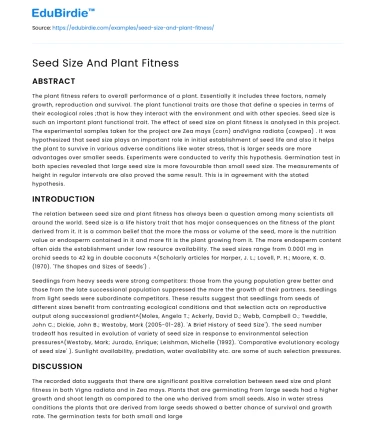ABSTRACT
The plant fitness refers to overall performance of a plant. Essentially it includes three factors, namely growth, reproduction and survival. The plant functional traits are those that define a species in terms of their ecological roles ;that is how they interact with the environment and with other species. Seed size is such an important plant functional trait. The effect of seed size on plant fitness is analysed in this project. The experimental samples taken for the project are Zea mays (corn) andVigna radiata (cowpea) . It was hypothesized that seed size plays an important role in initial establishment of seed life and also it helps the plant to survive in various adverse conditions like water stress, that is larger seeds are more advantages over smaller seeds. Experiments were conducted to verify this hypothesis. Germination test in both species revealed that large seed size is more favourable than small seed size. The measurements of height in regular intervals are also proved the same result. This is in agreement with the stated hypothesis.
INTRODUCTION
The relation between seed size and plant fitness has always been a question among many scientists all around the world. Seed size is a life history trait that has major consequences on the fitness of the plant derived from it. It is a common belief that the more the mass or volume of the seed, more is the nutrition value or endosperm contained in it and more fit is the plant growing from it. The more endosperm content often aids the establishment under low resource availability. The seed sizes range from 0.0001 mg in orchid seeds to 42 kg in double coconuts ^(Scholarly articles for Harper, J. L.; Lovell, P. H.; Moore, K. G. (1970). 'The Shapes and Sizes of Seeds') .
Save your time!
We can take care of your essay
- Proper editing and formatting
- Free revision, title page, and bibliography
- Flexible prices and money-back guarantee
Seedlings from heavy seeds were strong competitors: those from the young population grew better and those from the late successional population suppressed the more the growth of their partners. Seedlings from light seeds were subordinate competitors. These results suggest that seedlings from seeds of different sizes benefit from contrasting ecological conditions and that selection acts on reproductive output along successional gradient^(Moles, Angela T.; Ackerly, David D.; Webb, Campbell O.; Tweddle, John C.; Dickie, John B.; Westoby, Mark (2005-01-28). 'A Brief History of Seed Size'). The seed number tradeoff has resulted in evolution of variety of seed size in response to environmental selection pressures^(Westoby, Mark; Jurado, Enrique; Leishman, Michelle (1992). 'Comparative evolutionary ecology of seed size' ). Sunlight availability, predation, water availability etc. are some of such selection pressures.
DISCUSSION
The recorded data suggests that there are significant positive correlation between seed size and plant fitness in both Vigna radiata and in Zea mays. Plants that are germinating from large seeds had a higher growth and shoot length as compared to the one who derived from small seeds. Also in water stress conditions the plants that are derived from large seeds showed a better chance of survival and growth rate. The germination tests for both small and large seeds under normal and stress conditions also proved the same result. In the case of reproductive fitness in Vigna radiata, the plants from larger seeds obtained reproductive maturity at a faster rate than those from smaller seeds.
This study suggests that plants germinating from large seeds perform better than the ones germinating from small seeds, provided they are sown under same conditions. However , this study can only be considered in a narrow view of dependence of seed size on plant fitness, since the seedsize can also influence other components of plant fitness like emergence, biomass production etc. Thus the variation in seed size plays a potential role in characteristics of the plant that derived from it, which in turn reflects in plant fitness.
REFERENCES
- Scholarly articles for Harper, J. L.; Lovell, P. H.; Moore, K. G. (1970)'The Shapes and Sizes of Seeds'.
- Moles, Angela T.; Ackerly, David D.; Webb, Campbell O.; Tweddle, John C.; Dickie, John B.; Westoby, Mark (2005-01-28). 'A Brief History of Seed Size'.
- Westoby, Mark; Jurado, Enrique; Leishman, Michelle (1992). 'Comparative evolutionary ecology of seed size'.






 Stuck on your essay?
Stuck on your essay?

